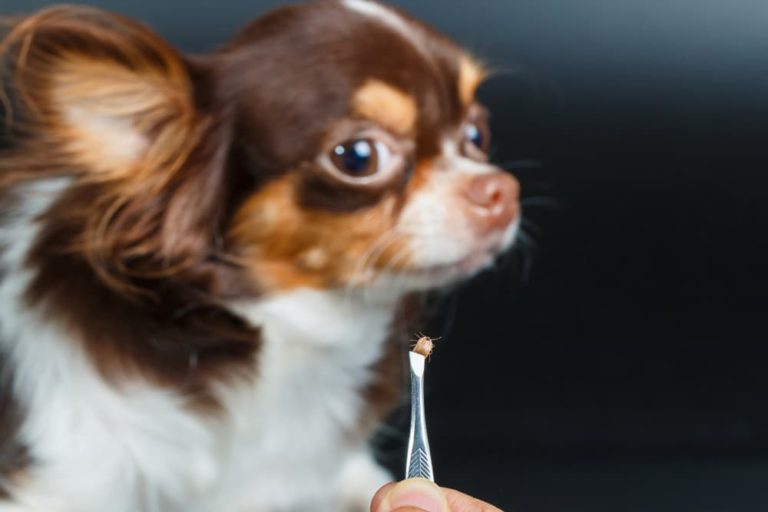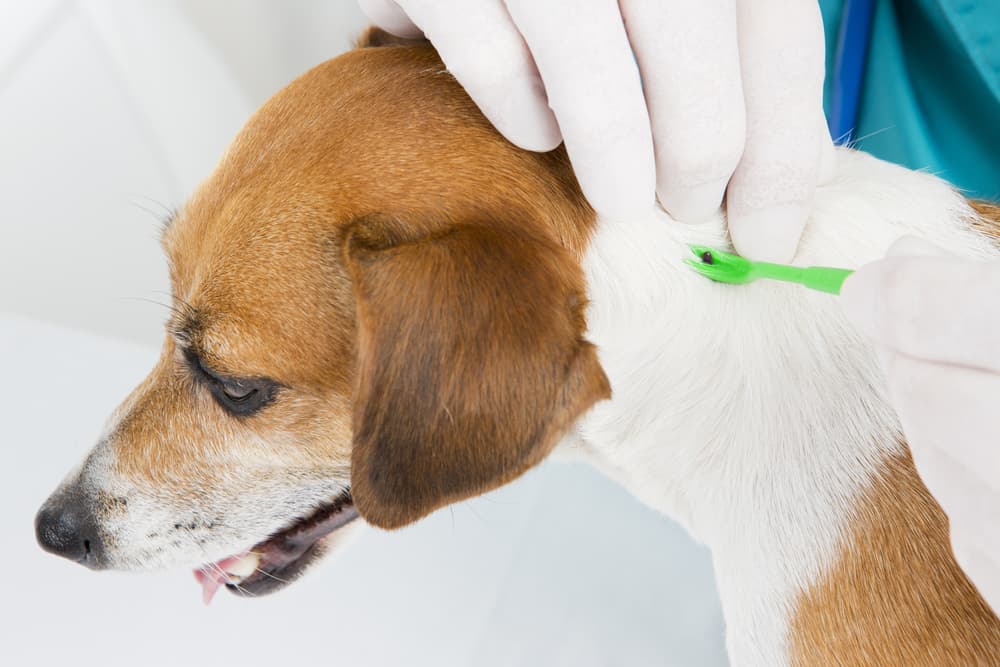How to Remove a Tick from a Dog

Learning to remove ticks is essential to your dog’s health. These parasites carry infectious diseases (like Lyme disease and Rocky Mountain spotted fever) that can set your dog up for unnecessary pain, discomfort, and medical issues. The sooner a tick is removed, the less opportunity there is for disease to spread. If you’re not certain how to remove a tick from a dog, we’ve broken it all down into simple steps.
We encourage you to contact your veterinarian if your dog is exhibiting abnormal symptoms after a tick bite. And although removing a tick from a dog isn’t too complicated once you get used to it, don’t be afraid to ask for help. “Most veterinarians will remove ticks in their office, so if you are not comfortable removing yourself, it is okay to consult the professionals,” says Dr. Katie Pagan, a partner veterinarian with Heart + Paw in Fells Point, Maryland.
Dog Tick Removal: What You’ll Need
These items will help ensure safe dog tick removal and make the process easier.
- A tick removal tool. The best way to remove ticks from dogs is to use a specialty tool. They’re available in a variety of designs including specialized tick tweezers, tick keys, tick scoops, and tick twisters.
- Plastic gloves. Because ticks can transmit disease to humans, it’s always better to be safe. “Experts agree that it is best if the person removing the tick wears protective gloves to prevent possible infection,” says Dr. Jerry Klein, chief veterinary officer for the American Kennel Club, based in New York City.
- Isopropyl (rubbing) alcohol. This has multiple uses, such as lessening the tick’s grip on your dog’s skin, killing the tick after removal, and disinfecting your tick tool.
- A lidded container or plastic storage bag. A container or bag provides a place to kill and dispose of the tick after it’s been removed, or to safely hold it if you need to bring it to your veterinarian for inspection.
- Antibiotic ointment or antiseptic. You’ll use this to clean the bite spot and prevent infection after removing the tick.
- A magnifying glass. Ticks are small, so having a magnifier can make it easier to find them.
- A dog treat. A favorite treat or food placed in a dog puzzle toy is a good way to keep your dog occupied and calm during the process.
How to Remove a Tick from a Dog

Before getting started, be sure you know how to identify a tick. They’re generally small and brown with a hard oval body and eight legs, and they can resemble a skin tag when embedded in the skin.
Once you know what to look for, you can start removing the tick from your dog.
Removing a Tick with Tweezers
Tweezers can be used on all sizes of ticks, and because they’re made of metal, they can easily be sterilized. One thing to consider is that tweezers have sharp ends, which can inadvertently stick your dog during the process.
Step 1: Prepare for tick removal. Gather all your supplies and have a dog treat ready in case you need to distract your pup. Then put on your gloves and get ready to locate the tick.
Step 2: Distract your dog. If your dog is not a fan of sitting still, try offering a treat, puzzle-toy, or lick mat with peanut butter as a means of distraction. It will be easier to remove the tick if your dog isn’t trying to get away from you.
Step 3: Locate and stabilize the tick. Part your dog’s fur to find the tick, then work to loosen its grip. “Placing a small amount of rubbing alcohol on a cotton ball and applying the cotton ball directly on top of the tick can sometimes work in backing the tick off of the skin,” says Dr. Pagan.
Step 4. Grasp the tick and pull it out. Now you’re ready for the actual dog tick removal part. To do this, firmly grasp the tick as close to the dog’s skin as possible, recommends Dr. Klein. “In a sustained, non-twisting motion, gently but firmly pull the tick out of the dog. Avoid bursting the tick on the dog to prevent infection.”
Veterinarians say it can help to aim for grabbing the head and mouth area.
Using a Dog Tick Removal Tool
There are several different types of tick removal tools, so we’re going to go over how to properly use each one.
Regardless of which tool you use, the first two steps listed above (prepare for tick removal and locate and stabilize the tick) will remain the same. Starting with step 3, here’s what you need to know about extracting a tick with different types of dog tick removal tools.
Tick Key
This tool resembles a metal key with a slot on the end. It’s simple to use, can easily be sterilized, and doesn’t have sharp edges. It may not be effective at removing smaller ticks, however.
How to use it: Instead of grabbing the tick as you would with tweezers, move the tick key across your dog’s skin, making sure the slot moves over the tick. Do this until the tick is removed.
Tick Scoop
A tick scoop is shaped like a measuring spoon, except that it has a v-shaped notch on the end for grabbing and removing the tick. This tool may not be as effective at grabbing smaller ticks, and because it’s made of plastic, it’s not as easy to disinfect as metal.
How to use it: Place the spoon’s notch on the skin near the tick, and using light pressure, slide the spoon forward so that the notch covers the tick. Keep sliding it forward until the tick is removed.
Tick Twister
This tool looks like something you might use in your garden to aerate soil and remove weeds. Tick twisters are available in two sizes, though both versions may be a bit cumbersome for pet parents with large hands and dogs with long fur.
How to use it: Slide the end of the twister toward the tick until it becomes stuck between the prongs. Then gently lift and twist it two or three times, and pull it up when the tick has released its mouth from your dog’s skin.
How to Remove a Tick Head from a Dog
If you’ve successfully removed the tick’s body but the head is still stuck in your dog’s skin, don’t panic. “The skin will eventually push the rest of the tick out over the next few days or weeks,” says Dr. Pagan.
Some dogs, she adds, may experience a reaction that can cause dermatitis, or a small area of redness on the skin, she adds. “Your vet may prescribe medication for this if it is severe, but most of the time it is very mild and goes away on its own once the entire tick is gone.”
You can always ask your veterinarian for guidance if the tick head is still embedded in the skin.
Things to Avoid When Removing Ticks from Dogs

There are some items that while convenient to use, are not recommended for removing ticks from dogs.
Your hands and fingers. Using your hands is an ineffective way to remove a tick, plus “It could burst and pass infectious bacteria into small cuts in your skin,” says Dr. Klein.
Improper tick remover tools. It may be tempting to use something you have around the house (like a credit card or lit match) for dog tick removal, but don’t. “These methods are riskier and may not cause proper removal of the tick,” Dr. Klein warns.
Olive oil. According to Dr. Klein, Some people have tried placing olive oil on the site to suffocate the tick, but he doesn’t recommend it. “This may make the tick too slippery to remove properly,” he explains.
Petroleum jelly. This is another slippery substance that “tends to irritate the skin more,” says Dr. Pagan. Petroleum jelly can also cause a tick to regurgitate saliva into the wound, which increases the risk of infection.
Vinegar. Apple cider vinegar has antiseptic and antibacterial properties and other beneficial uses for dogs. Still, Dr. Pagan recommends against using it to remove ticks because “It tends to irritate the skin more.”
Soap and water. Though soap and water is a must for washing your hands and the tick tool, current evidence shows that it’s minimally effective at removing a tick from a dog. It’s better to use tweezers or a proper tick removal tool.
What to Do After Removing a Tick from Dog
Now that you’ve removed the tick, there are a few important follow-up steps to remember.
Kill and dispose of the tick. You can kill the tick by dousing it in rubbing alcohol, says Dr. Klein. “Then either flush it down the toilet or place it in an airtight container and bring [it] into your vet in case they would like to visualize the tick and submit it for analysis.”
Apply an antiseptic to your dog’s skin. Veterinarians recommend dabbing some alcohol on a cotton ball to the area of the dog’s skin to help prevent infection. Or you can use an antibacterial cream or ointment designed for pets.
Search for other ticks. Once a tick has been introduced into your home, it’s easy for them to reproduce, so be diligent about looking for others. “It is imperative to search your dog for any additional ticks,” says Dr. Pagan. If you do find one, repeat the steps for removing a tick with your tool.
Wash your hands and sterilize your equipment. Because humans are at risk for developing tick-borne illnesses, experts recommend washing your hands thoroughly with soap and warm water after removing a tick from a dog. You should also wash your tick removal tool with rubbing alcohol or soap.
Monitor your dog for signs of dermatitis. If your dog’s skin appears red and irritated, contact your veterinarian, recommends Dr. Pagan. “Most cases of tick dermatitis are mild, but if it is severe, your vet may need to prescribe medication.”
How to Prevent Tick Bites on Dogs

Though no technique is foolproof for preventing tick bites, a few basic practices can go a long way.
Use Proper Preventatives
Using a year-round preventative on your dog is essential. Formulas are usually combined with flea preventative medicine and come in a variety of forms including topical ointments, collars, and chews. “These products will kill the ticks right away before they have the chance to transmit any diseases,” says Dr. Pagan. Your veterinarian can recommend the product most appropriate for your dog.
Check Your Dog for Ticks on a Regular Basis
By performing daily tick checks on your dog, you’re in a better position to eradicate it and stop the spread of any disease. This is especially helpful, says Dr. Klein, “if [you’re] living in an endemic area or have pursued activities in areas such as grassy or sandy environments.”
Ticks like to hide around dogs’ ears and between the toes, so pay close attention to these areas and other “hidden” locations.
Maintain Good Sanitation Practices
Wash and (if needed) disinfect any blankets and sheets your dog sleeps on, and regularly vacuum your rugs, furniture, and drapes, Dr. Klein recommends. And don’t forget to clean your outdoor area. “Keep wood piles and leaves cleaned and away from your home,” he adds. Since ticks feed on other animals, finding ways to deter wildlife from entering your yard can also help reduce the risk.









